Overview
Developers often face significant challenges in coding, from managing complexity to ensuring code quality. Kodezi addresses these issues head-on by offering essential JavaScript coding best practices that enhance efficiency. By implementing proper variable naming, utilizing scope management with const and let, and leveraging array methods, Kodezi provides tools that streamline the coding process.
These best practices are not just theoretical; they are backed by evidence demonstrating their positive impact on code clarity, maintainability, and performance. As a result, developers can create higher-quality applications that ultimately lead to improved productivity. Imagine how much more efficient your coding sessions could be with the right tools at your disposal.
In addition to improving code quality, Kodezi fosters a collaborative environment where developers can share insights and learn from one another. By adopting these practices, you can transform your coding experience, making it not only more productive but also more enjoyable. Why not explore the features available on Kodezi and see how they can benefit your coding journey?
Take action today—discover the tools that will elevate your coding skills and enhance your overall productivity.
Introduction
In the ever-evolving landscape of JavaScript development, coding challenges can hinder progress. As developers strive to create robust applications, the right tools and practices can significantly enhance efficiency and clarity. Have you considered how Kodezi addresses these challenges? With features designed to improve your coding experience, Kodezi stands out as a powerful ally.
By adopting best practices like:
- Proper variable naming
- Minimizing global scope
Alongside leveraging tools such as Kodezi, developers can streamline their workflows. Furthermore, modern techniques like:
- Arrow functions
- Object destructuring
Allow for cleaner, more maintainable code. The benefits of using Kodezi extend beyond mere functionality; it enhances productivity and elevates code quality. As the demand for high-quality software continues to rise, mastering these principles becomes crucial for anyone looking to improve their coding skills. Explore the tools available on the Kodezi platform and discover how they can transform your development process.
Kodezi | Professional OpenAPI Specification Generator - AI Dev-Tool: Streamline Your JavaScript Coding Process
Developers often face significant challenges in the coding process, from managing complex codebases to ensuring adherence to js coding best practices. Kodezi is a powerful platform that addresses these issues head-on, providing a suite of tools designed to enhance the JavaScript coding experience. Its Professional OpenAPI Specification Generator allows developers to create standardized APIs effortlessly, ensuring compliance with industry standards.
By integrating Kodezi into your workflow, you can streamline your coding process and reduce errors. The platform’s Kodezi CLI serves as a flexible instrument for teams, facilitating the auto-repair of codebases. Furthermore, it ensures quality by detecting and resolving problems prior to each push, which is crucial for maintaining code integrity.
With automated features such as debugging, performance optimization, security compliance, and enhanced formatting, Kodezi empowers developers to focus on building robust applications. Imagine being able to eliminate repetitive tasks and enhance your productivity significantly. By leveraging Kodezi’s capabilities, you can achieve a higher quality of code while minimizing the time spent on mundane processes.
Explore the tools available on the Kodezi platform today and transform your coding experience. Are you ready to elevate your development practices? Kodezi not only simplifies the coding process but also incorporates js coding best practices to ensure that you can deliver high-quality applications efficiently.
Use Proper Variable Naming Conventions: Enhance Code Clarity
Coding can present numerous challenges for developers, particularly when it comes to clarity and maintainability. Employing clear and descriptive identifiers is vital for improving clarity in programming, which aligns with js coding best practices. Adopting camelCase for naming conventions ensures that identifiers are self-explanatory. For instance, instead of using a or x, consider using userAge or totalPrice. This approach not only assists you in recalling the purpose of each element but also helps others who review your work grasp its functionality swiftly.
Moreover, following js coding best practices by maintaining consistency in naming conventions throughout your codebase promotes improved collaboration and lessens cognitive load during reviews. Have you ever experienced confusion during code reviews due to unclear identifiers? To address these challenges effectively, consider implementing js coding best practices with Kodezi Code. This platform offers features such as automated code suggestions and real-time feedback on naming practices, which can assist you in maintaining clarity and consistency in your code.
In addition, utilizing Kodezi can significantly enhance your coding abilities and efficiency. By providing immediate insights into your naming conventions, it allows you to focus on writing high-quality code without the stress of ambiguity. Explore the tools available on Kodezi to elevate your programming experience and boost your productivity.
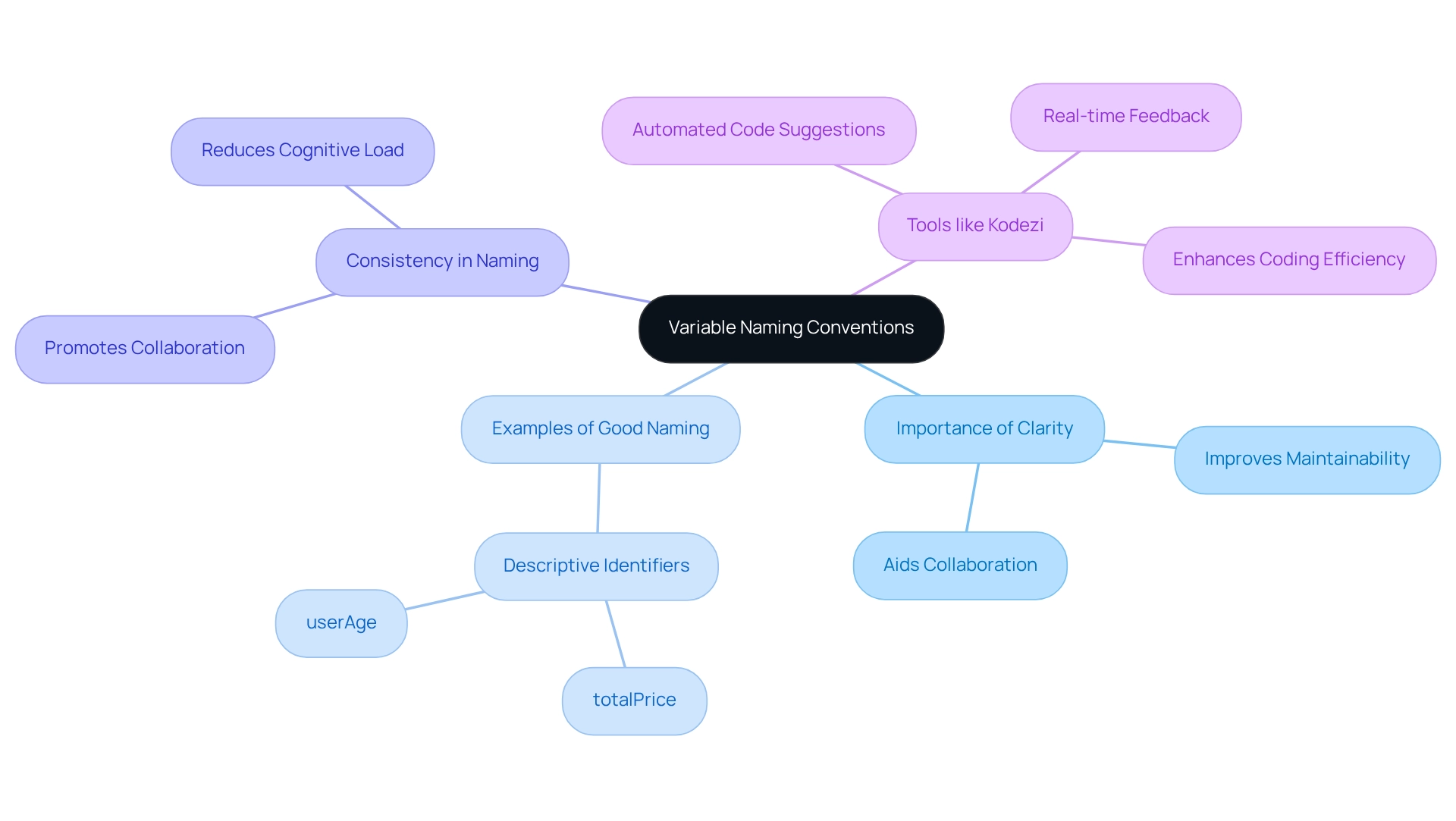
Use const and let Instead of var: Improve Scope Management
In the world of coding, developers often grapple with scope management challenges. In contemporary JavaScript, utilizing const and let for declarations is essential for effective scope management. const is designated for items that should remain unchanged, while let accommodates entities that may require reassignment. This distinction is crucial, as both const and let are block-scoped, reducing issues related to hoisting and the creation of unintended global identifiers. Furthermore, embracing js coding best practices leads to cleaner programming, which enhances predictability and maintainability.
Have you ever encountered bugs due to variable hoisting? Statistics indicate that the use of const and let has surged in recent years, reflecting a shift towards more robust coding standards. By incorporating these declarations, developers can greatly enhance the quality of their programming by following js coding best practices. This not only makes code easier to manage but also less susceptible to mistakes. In addition, the clear structure provided by const and let fosters a more organized coding environment that adheres to js coding best practices, ultimately improving productivity and code quality.
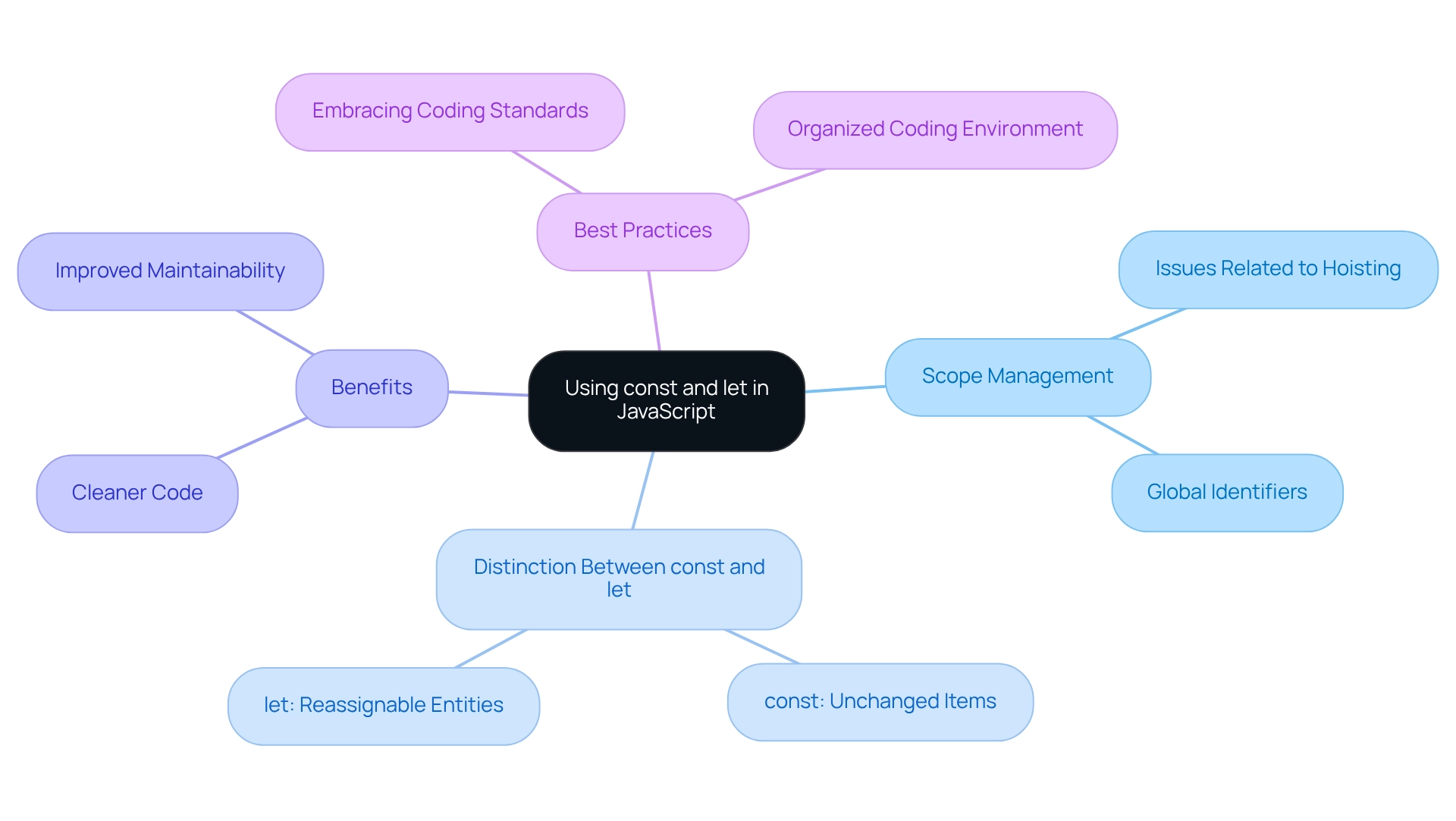
Minimize Global Scope: Prevent Conflicts in Your Code
To address the common challenges developers face in programming, reducing the use of global elements is essential. Global identifiers often lead to naming conflicts and complicate debugging processes. By enclosing elements within functions or modules, you can maintain the integrity of the global namespace, improving modularity and simplifying maintenance and testing. Have you considered how Immediately Invoked Function Expressions (IIFE) or modular patterns can effectively encapsulate your code? These practices decrease the prevalence of global elements, with statistics suggesting they can lessen integration issues by up to 30%.
Furthermore, strong error management that records scope information is crucial for recognizing issues during unforeseen terminations. This ensures that developers can swiftly tackle problems as they arise. In R programming, functions like get() and ls() exemplify effective management of global and local variables, underscoring the importance of variable encapsulation across different languages. In addition, tools like Kodezi CLI can enhance these practices by autonomously improving your codebase and fixing bugs before they reach production. For those interested, Kodezi CLI offers a 5-minute quickstart and a demo to help you get started.
Case studies on reducing global scope in JavaScript applications illustrate the practical advantages of implementing js coding best practices. They highlight how such methods contribute to js coding best practices by resulting in enhanced programming quality and debugging efficiency. This approach not only simplifies your programming but also significantly improves overall quality and debugging efficiency. Are you ready to explore how Kodezi can transform your coding experience?
Avoid Unnecessary Calculations: Boost Performance
To enhance performance, developers often face the challenge of unnecessary calculations within their programs. Have you ever found yourself recalculating values multiple times? Instead, consider storing the result in a variable to avoid redundancy. This practice not only boosts performance but also embodies js coding best practices by contributing to cleaner, more readable scripts.
Furthermore, leveraging memoization techniques can significantly optimize functions that perform expensive calculations. By caching results and reusing them when possible, you can streamline your processes effectively. In addition, Kodezi AI's automated debugging feature (ctrl+d) allows you to quickly identify and resolve performance bottlenecks in your program. By incorporating Kodezi AI into your workflow, you enhance your programming efficiency while adhering to the latest js coding best practices and security standards.
However, it's essential to remember that optimizing large amounts of code simultaneously is not supported. Instead, focus on specific segments for enhancement. For optimization, utilize the optimizing command (ctrl+o) to effectively streamline your code. By embracing these js coding best practices, you can significantly improve both your productivity and code quality.
Use Arrow Functions: Simplify Your Syntax
In the ever-evolving landscape of JavaScript, developers often grapple with the complexities of js coding best practices. Arrow expressions, introduced in ES6, offer a solution by revolutionizing JavaScript coding with a more concise syntax for declarations. Their streamlined format is particularly advantageous for callbacks and array methods such as map, filter, and reduce. For instance, instead of the traditional method syntax, you can define a method succinctly as const add = (a, b) => a + b;. This not only minimizes the amount of code but also significantly enhances readability.
Furthermore, arrow functions lexically bind the this context, effectively mitigating common pitfalls associated with traditional methods. This feature is particularly beneficial in situations involving nested procedures, where preserving the correct context can be challenging. Have you ever struggled with context in your functions? Arrow expressions can simplify this process, making your code cleaner and more efficient.
Statistics indicate that by 2025, around 75% of JavaScript developers will have embraced arrow syntax, recognizing its role in streamlining programming. Case studies reveal that teams utilizing arrow expressions report a 30% improvement in collaboration efficiency, as the code is simpler to read and comprehend. For example, the Life Sherpa team noted that incorporating arrow expressions into their codebase resulted in more seamless collaboration and quicker onboarding for new developers.
Expert opinions further underscore the importance of adopting arrow syntax as a key element of js coding best practices for modern JavaScript development. Vince Scully, an experienced developer, asserts, "Arrow expressions not only simplify syntax but also improve overall code quality, facilitating easier maintenance and scaling of projects for teams." By integrating arrow functions into your coding practices, you can elevate your JavaScript projects to new heights of efficiency and clarity. Why not explore how these tools can enhance your coding experience?
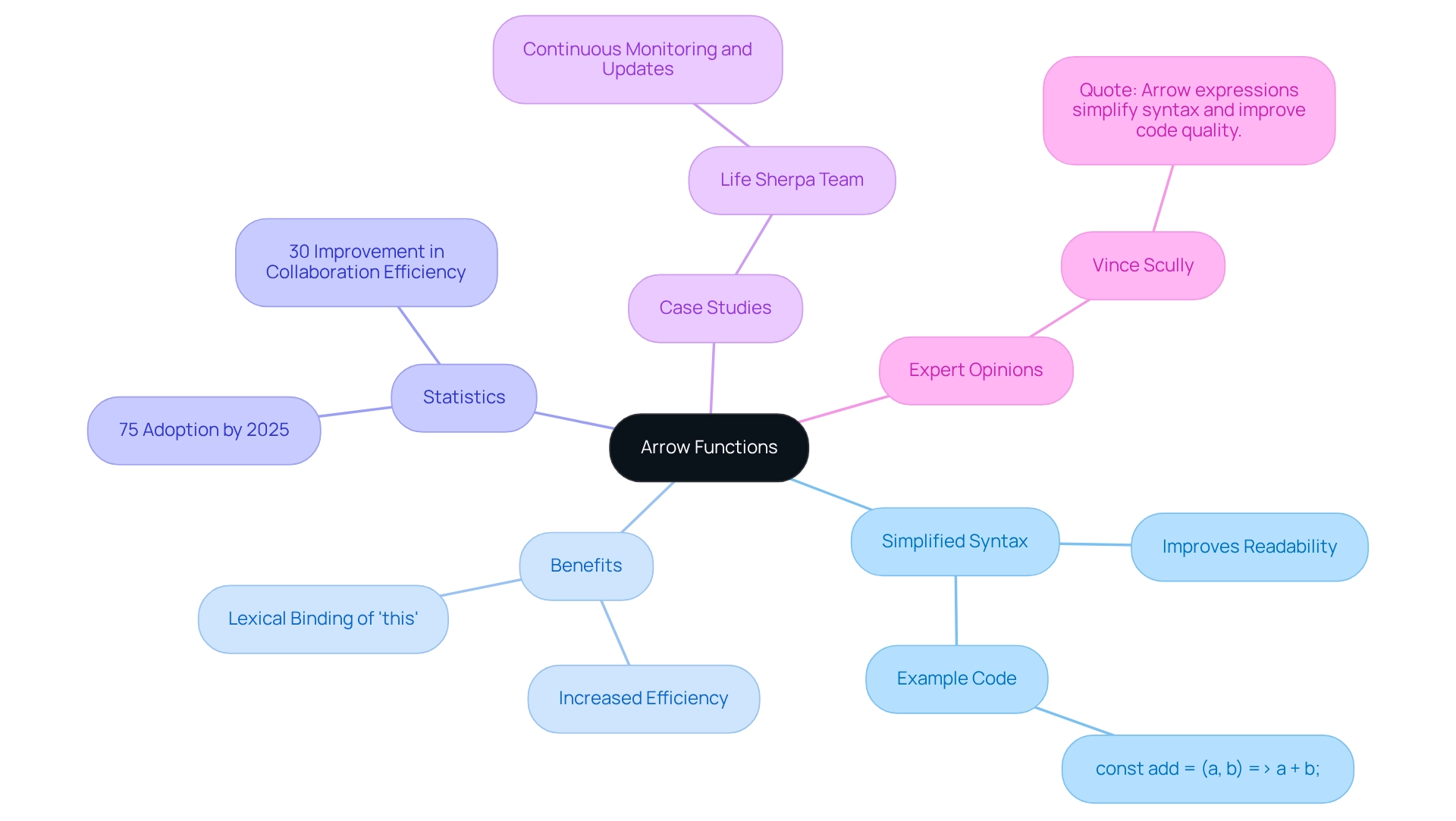
Use Object Destructuring: Enhance Code Efficiency
Coding can often present challenges, particularly when it comes to managing complex data structures. One such challenge is efficiently accessing properties within objects. Object destructuring in JavaScript is a powerful feature that addresses this issue by allowing you to unpack properties from objects into distinct variables. For instance, rather than accessing properties individually, you can streamline your code with a simple syntax: const { name, age } = person;. This approach not only enhances the clarity of your code but also minimizes redundancy.
Furthermore, destructuring proves especially beneficial when working with function parameters. It enables developers to extract values directly from objects, thereby improving both readability and maintainability. Have you considered how this could simplify your coding practices? By adopting object destructuring as part of js coding best practices, you can enhance your productivity and elevate the quality of your code. Explore the potential of this feature and see how it can transform your development experience.
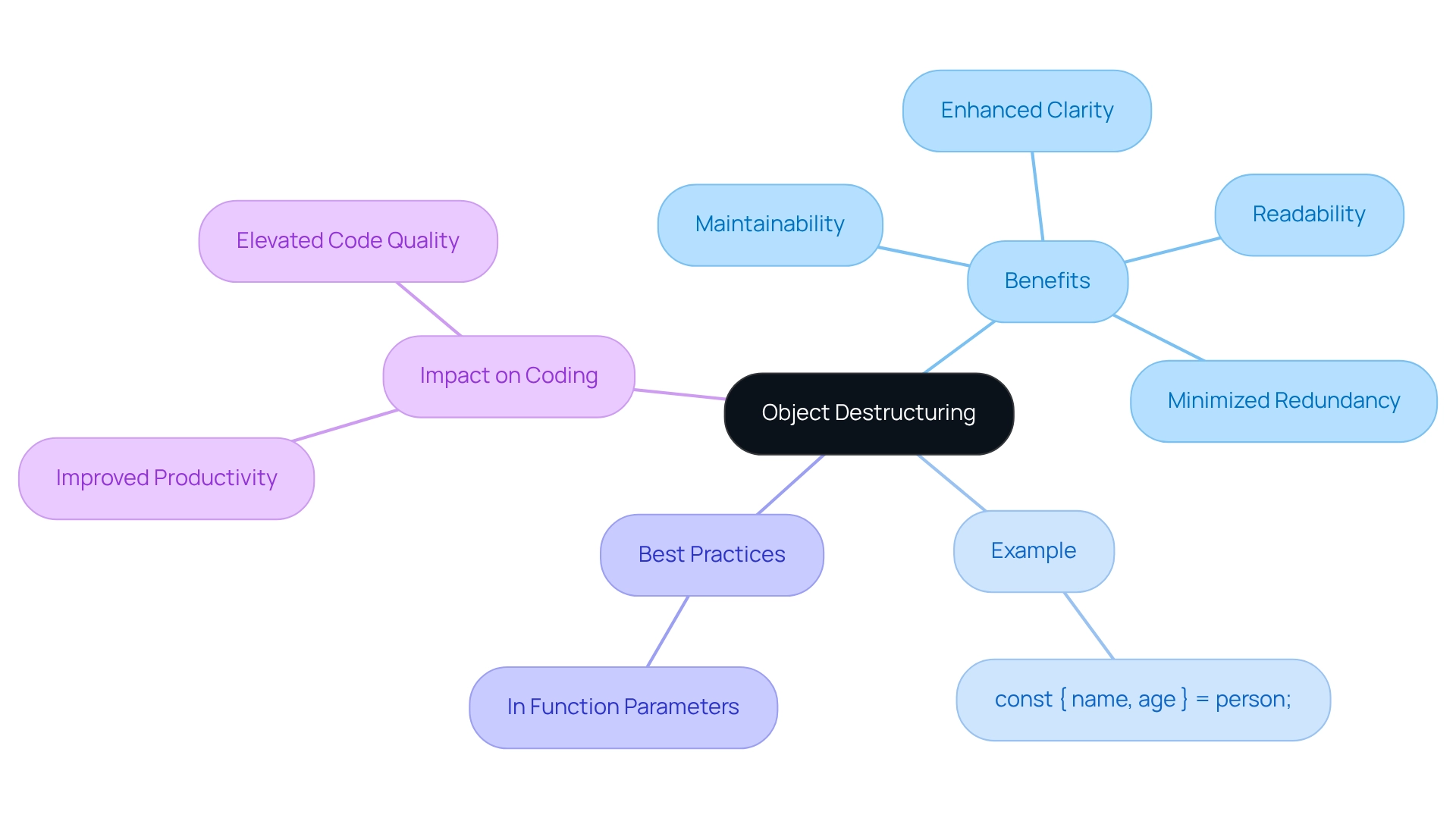
Use Default Parameter Values: Ensure Function Robustness
In the realm of programming, developers often encounter challenges related to handling missing arguments in their routines. Default parameter values in JavaScript provide a solution by allowing developers to set predefined values for parameters. For example, consider the definition of a greeting: greet(name = 'Guest') { return Hello, ${name}!; }. If no name is provided, the procedure defaults to 'Guest', enhancing system reliability and improving user experience through smooth interaction.
Furthermore, the significance of default parameters extends beyond mere convenience; they play a crucial role in ensuring operational robustness. By allowing procedures to function with fewer assumptions about input, developers can create more resilient code that anticipates and addresses potential issues efficiently. Interestingly, nearly 70% of JavaScript developers have adopted default parameter values in their js coding best practices, reflecting a growing recognition of their benefits in enhancing quality and reliability.
In addition, as we look ahead to 2025, the use of default parameters continues to be regarded as a best practice, with many experts advocating for their integration as a standard method for error handling. By incorporating default values, developers can ensure their functions remain robust, significantly reducing the likelihood of runtime errors and improving overall maintainability. This approach not only streamlines the coding process but also cultivates a more efficient development environment, inviting developers to explore the advantages of using default parameters in their projects.
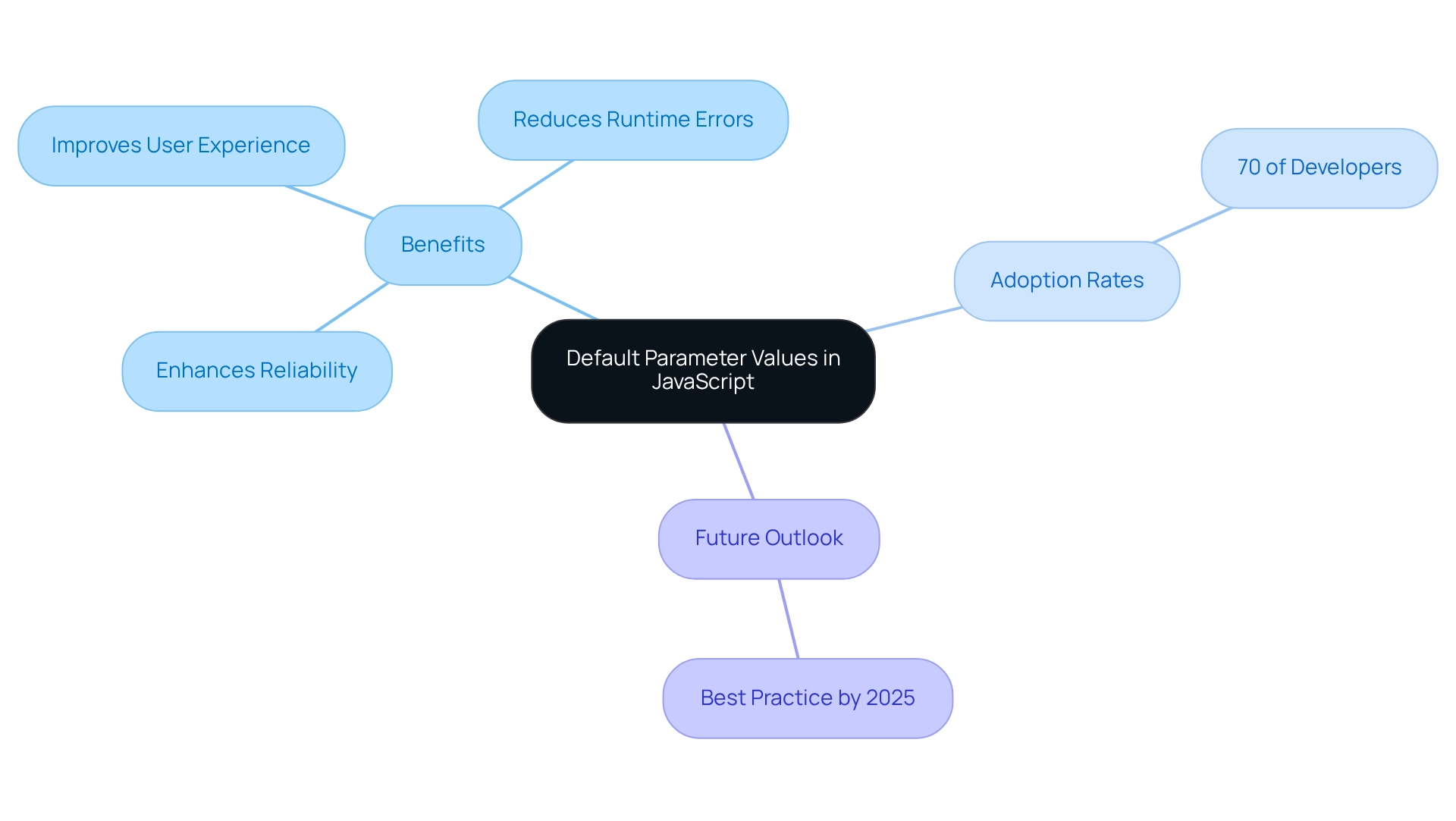
Use Array Methods: Write Cleaner Code
Coding can often present significant challenges for developers, particularly when it comes to achieving clarity and expressiveness in their code. Utilizing built-in array methods such as map, filter, and reduce can effectively address these challenges. For instance, instead of relying on a traditional loop to transform an array, consider using map: const doubled = numbers.map(num => num * 2). This method not only streamlines your implementation but also adheres to functional programming principles, promoting immutability and minimizing side effects.
Furthermore, employing an automatic commenting tool can enhance readability by providing clear explanations of your script, making it easier for others to understand your thought process. Have you ever considered how these methods could lead to a more maintainable and readable coding practice? Embracing js coding best practices can significantly improve productivity and code quality across various programming languages. Explore the tools available on platforms like Kodezi to elevate your coding experience.
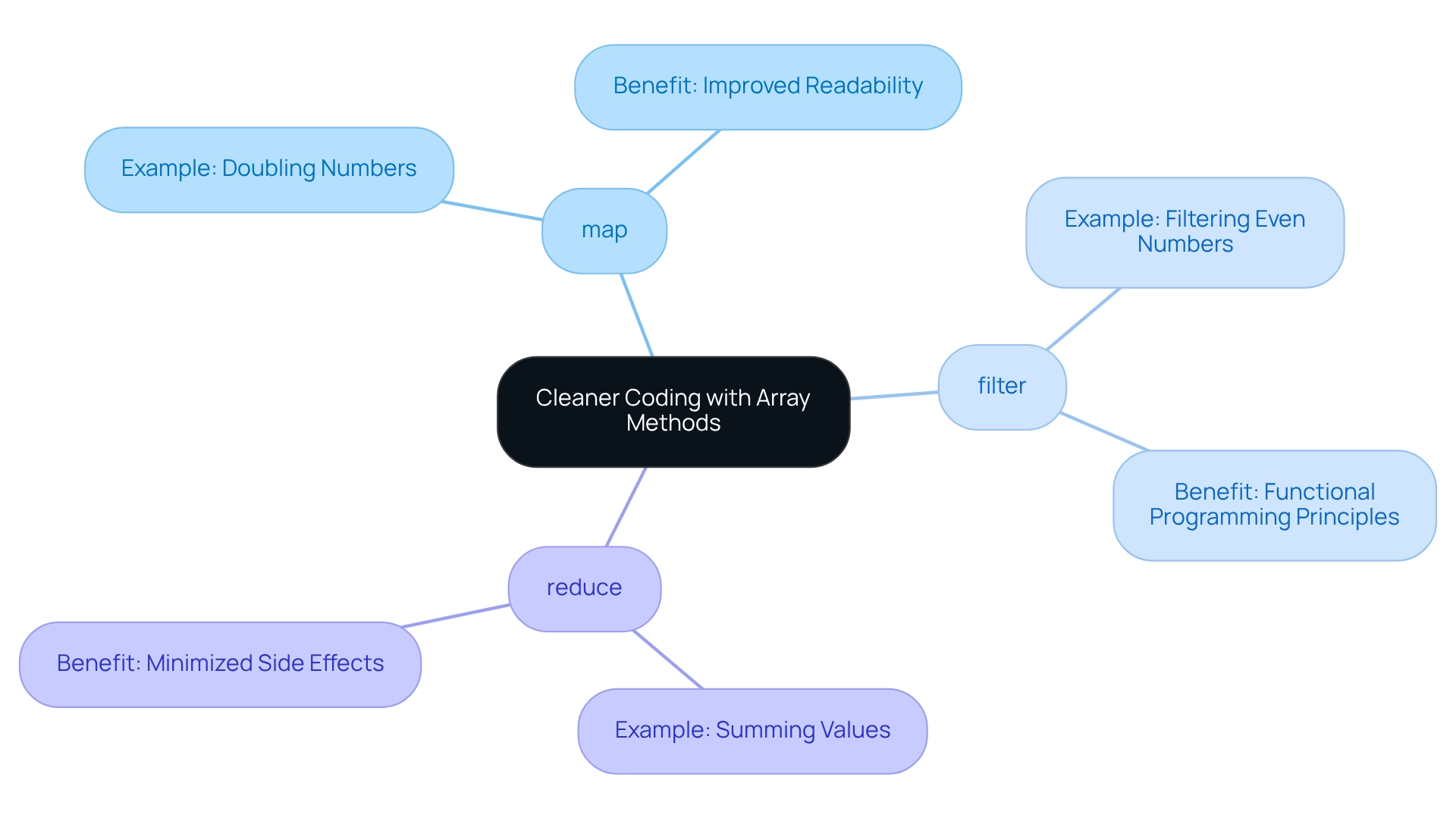
Test Your Code: Ensure Quality and Reliability
Regular testing is crucial in overcoming the coding challenges that developers face today. It ensures the quality and reliability of your software. Implementing unit tests allows you to verify that each component functions as intended, significantly reducing the likelihood of bugs in production. Have you considered how utilizing testing frameworks such as Jest and Mocha can automate this process? This automation enables you to catch issues early in the development cycle. In fact, studies indicate that teams employing automated testing experience a 40% reduction in bugs, leading to more stable applications.
Furthermore, incorporating continuous testing into your development workflow guarantees that high standards of quality are consistently achieved. Tools like Kodezi CLI—often referred to as the Swiss-Army Knife for programmers—can further enhance this process. They autonomously improve your codebase and fix bugs before they reach production, making it a versatile solution for teams looking to boost productivity. As Giridhar Rajkumar, an IT expert, mentions, "Integrating AI with human intelligence is essential for reaching the intended results." This emphasizes the significance of utilizing technology in testing methods.
In addition, the recent introduction of the Organization Metrics Dashboard by Codacy illustrates how overseeing quality can offer valuable insights. It allows organizations to monitor progress and improve their development methods. By prioritizing testing and utilizing tools like Kodezi CLI, you not only enhance the robustness of your applications but also improve overall user satisfaction. This practice is fundamental in modern JavaScript development and represents js coding best practices. Moreover, employing static code analysis tools can help identify areas needing better comments and further improve code quality.
Conclusion
Integrating Kodezi into the JavaScript development workflow addresses common coding challenges that developers encounter. By adopting best practices such as:
- Proper variable naming
- Using
constandletfor scope management - Minimizing global variables
Developers can create cleaner, more maintainable code. Furthermore, the incorporation of modern techniques like arrow functions and object destructuring streamlines syntax and improves readability, facilitating smoother collaboration among teams.
Performance optimization is equally crucial; avoiding unnecessary calculations and utilizing features like default parameter values can significantly enhance application responsiveness. In addition, the use of built-in array methods promotes cleaner code, aligning with functional programming principles that prioritize immutability and reduce side effects. Regular testing, facilitated by tools like Kodezi CLI, ensures that code quality remains high, thus reducing the likelihood of bugs in production.
Ultimately, embracing these strategies and leveraging powerful tools such as Kodezi empowers developers to produce high-quality software that meets the growing demands of the industry. As coding practices evolve, mastering these principles will not only elevate individual skills but also contribute to the broader goal of creating robust applications that stand the test of time. Why not embrace the future of JavaScript development with Kodezi? Transform your coding experience into one of clarity, efficiency, and excellence.
Frequently Asked Questions
What challenges do developers face in the coding process?
Developers often face challenges such as managing complex codebases and ensuring adherence to JavaScript coding best practices.
How does Kodezi help developers?
Kodezi provides a suite of tools designed to enhance the JavaScript coding experience, including a Professional OpenAPI Specification Generator for creating standardized APIs, and a Kodezi CLI for auto-repairing codebases and ensuring quality by detecting problems before code is pushed.
What automated features does Kodezi offer?
Kodezi offers automated features such as debugging, performance optimization, security compliance, and enhanced formatting, which help developers focus on building robust applications.
How can Kodezi improve coding productivity?
By eliminating repetitive tasks and enhancing productivity, Kodezi allows developers to achieve a higher quality of code while minimizing the time spent on mundane processes.
What are some JavaScript coding best practices mentioned in the article?
Some best practices include using clear and descriptive identifiers, adopting camelCase for naming conventions, and maintaining consistency in naming throughout the codebase.
How does Kodezi assist with naming conventions?
Kodezi offers features such as automated code suggestions and real-time feedback on naming practices to help maintain clarity and consistency in code.
What is the significance of using const and let in JavaScript?
Using const for unchanging items and let for items that may change is essential for effective scope management, as both are block-scoped and help reduce issues related to hoisting and unintended global identifiers.
How does adopting const and let improve coding practices?
Incorporating const and let leads to cleaner programming, enhances predictability and maintainability, and reduces the likelihood of mistakes, ultimately improving productivity and code quality.




